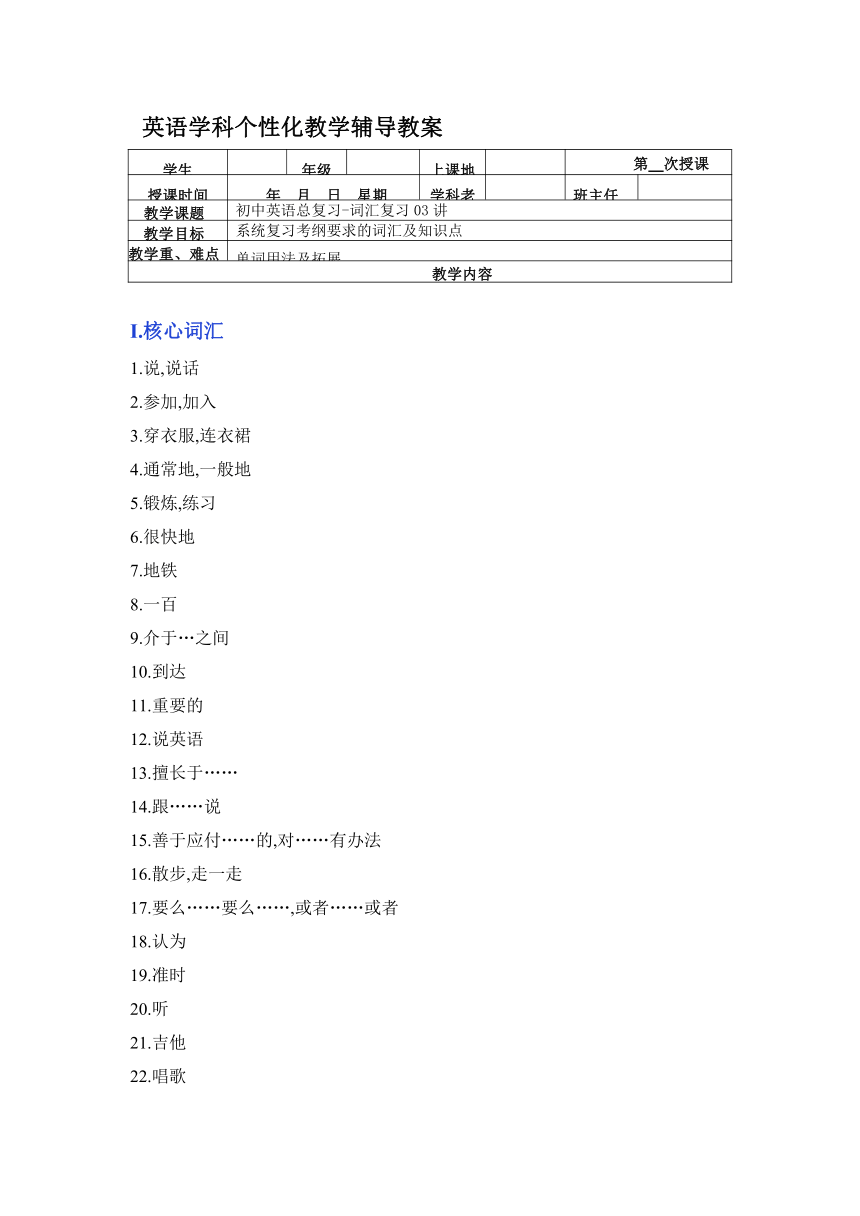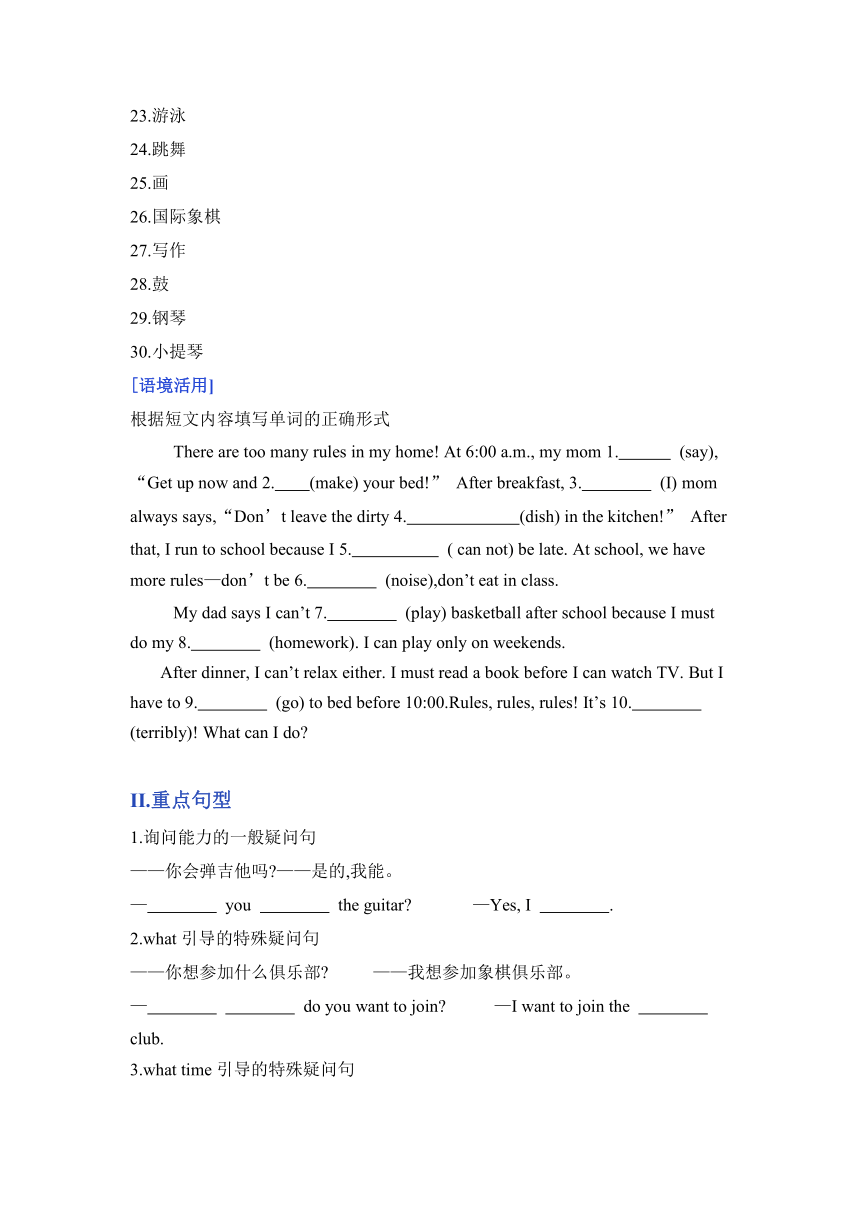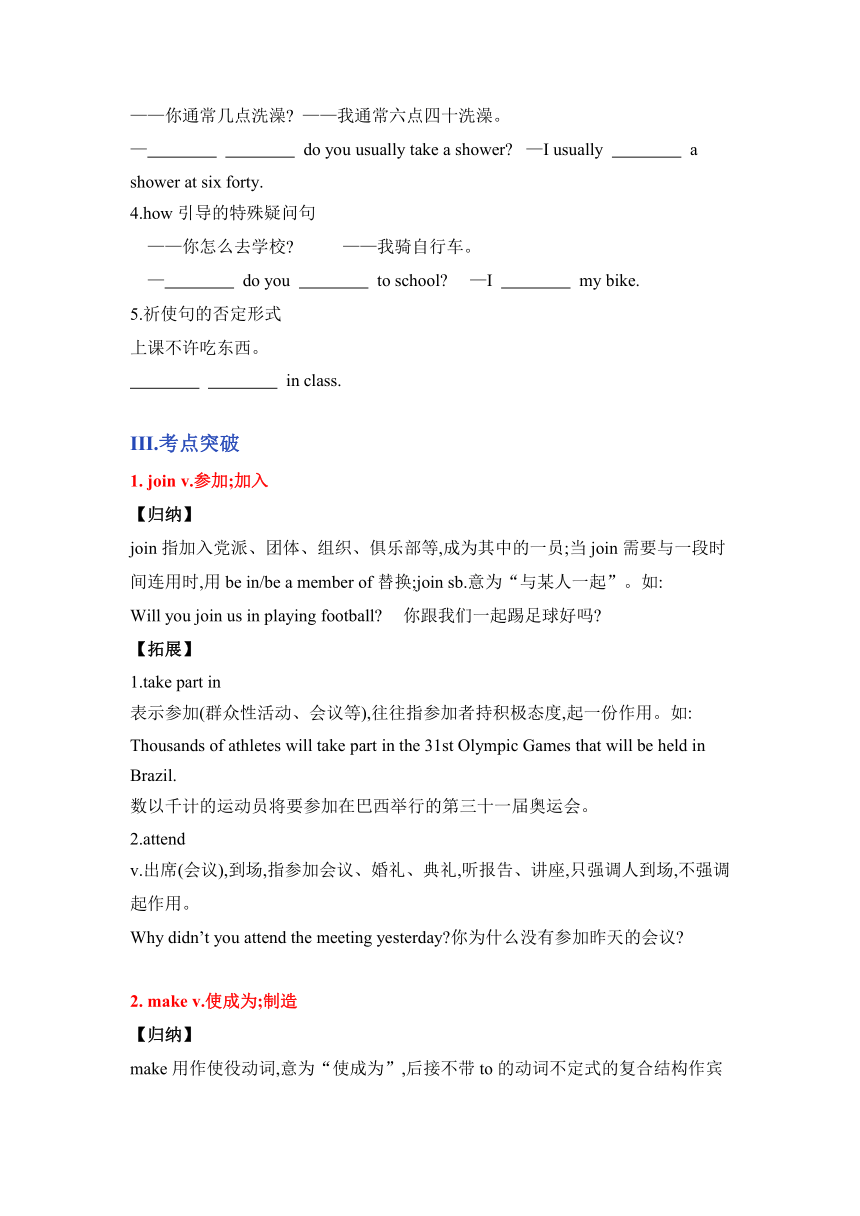中考英语词汇复习课时讲义七年级下册Unit1-Unit4(word版)
文档属性
| 名称 | 中考英语词汇复习课时讲义七年级下册Unit1-Unit4(word版) |  | |
| 格式 | zip | ||
| 文件大小 | 20.8KB | ||
| 资源类型 | 教案 | ||
| 版本资源 | 人教新目标(Go for it)版 | ||
| 科目 | 英语 | ||
| 更新时间 | 2022-01-04 09:44:21 | ||
图片预览



文档简介
英语学科个性化教学辅导教案
学生 年级 上课地点 第 次授课
授课时间 年 月 日 星期 学科老师 班主任
教学课题 初中英语总复习-词汇复习03讲
教学目标 系统复习考纲要求的词汇及知识点
教学重、难点 单词用法及拓展
教学内容
I.核心词汇
1.说,说话
2.参加,加入
3.穿衣服,连衣裙
4.通常地,一般地
5.锻炼,练习
6.很快地
7.地铁
8.一百
9.介于…之间
10.到达
11.重要的
12.说英语
13.擅长于……
14.跟……说
15.善于应付……的,对……有办法
16.散步,走一走
17.要么……要么……,或者……或者
18.认为
19.准时
20.听
21.吉他
22.唱歌
23.游泳
24.跳舞
25.画
26.国际象棋
27.写作
28.鼓
29.钢琴
30.小提琴
[语境活用]
根据短文内容填写单词的正确形式
There are too many rules in my home! At 6:00 a.m., my mom 1. (say),“Get up now and 2. (make) your bed!” After breakfast, 3. (I) mom always says,“Don’t leave the dirty 4. (dish) in the kitchen!” After that, I run to school because I 5. ( can not) be late. At school, we have more rules—don’t be 6. (noise),don’t eat in class.
My dad says I can’t 7. (play) basketball after school because I must do my 8. (homework). I can play only on weekends.
After dinner, I can’t relax either. I must read a book before I can watch TV. But I have to 9. (go) to bed before 10:00.Rules, rules, rules! It’s 10. (terribly)! What can I do
II.重点句型
1.询问能力的一般疑问句
——你会弹吉他吗 ——是的,我能。
— you the guitar —Yes, I .
2.what引导的特殊疑问句
——你想参加什么俱乐部 ——我想参加象棋俱乐部。
— do you want to join —I want to join the club.
3.what time引导的特殊疑问句
——你通常几点洗澡 ——我通常六点四十洗澡。
— do you usually take a shower —I usually a shower at six forty.
4.how引导的特殊疑问句
——你怎么去学校 ——我骑自行车。
— do you to school —I my bike.
5.祈使句的否定形式
上课不许吃东西。
in class.
III.考点突破
1. join v.参加;加入
【归纳】
join指加入党派、团体、组织、俱乐部等,成为其中的一员;当join需要与一段时间连用时,用be in/be a member of替换;join sb.意为“与某人一起”。如:
Will you join us in playing football 你跟我们一起踢足球好吗
【拓展】
1.take part in
表示参加(群众性活动、会议等),往往指参加者持积极态度,起一份作用。如:
Thousands of athletes will take part in the 31st Olympic Games that will be held in Brazil.
数以千计的运动员将要参加在巴西举行的第三十一届奥运会。
2.attend
v.出席(会议),到场,指参加会议、婚礼、典礼,听报告、讲座,只强调人到场,不强调起作用。
Why didn’t you attend the meeting yesterday 你为什么没有参加昨天的会议
2. make v.使成为;制造
【归纳】
make用作使役动词,意为“使成为”,后接不带to的动词不定式的复合结构作宾语,常用make sb.do sth.意为“使某人做某事”;
His little sister made him cry. 他小妹妹把他弄哭了。
若make为被动语态,则不定式必须带to。
He was made to cry by his little sister. 他被他小妹妹弄哭了。
【拓展】
make常用词组小结
make a mistake 犯错误 make a noise 大声抱怨
make a telephone call 打电话 make friends with 与……交朋友
make a decision 作出决定 make a face 做鬼脸
make a living 谋生;维持生活 make it 约定时间;做到;按时到达
make money 赚钱 make one’s bed 铺床;收拾床铺
make sure 确信;务必;弄清楚
3.辨析wear, put on, dress和be in
wear 穿;戴
强调穿的状态,宾语可以为服装、鞋帽、眼镜、头发、胡须等
put on穿上;戴上
强调动作,宾语通常是衣服、鞋帽;宾语若是代词必须放在put和on之间,反义短语是take off(脱下)
dress给……穿衣服
表示穿的动作或状态,主语通常是人。常用短语:dress sb.给某人穿衣服(动作),dress oneself给自己穿衣服,be/get dressed in...穿着……(状态),dress up(as)...装扮成……
be in穿着
后跟衣服、帽子等,也可跟颜色,可以和wear或have sth. on替换,不能用于进行时态
4. be good with...善于应付…的;对…有办法
【归纳】
be good with...后接表示人或物的名词。
He is very good with the children. 他与这些孩子处得很好。
【拓展】
be good...常用短语
1.be good at意为“擅长于……”,后接名词、代词或v.-ing形式,同义短语是do well in。
2.be good to意为“对……友好”。
3.be good for意为“对……有益/有好处”,反义短语是: be bad for...对……有害。
5.either...or...的用法
【归纳】
either...or...意为“要么……要么……;或者……或者……”,连接两个表示选择关系的名词或代词。当该名词、代词作主语时,谓语动词要与最邻近的主语保持一致。
Either you or I am wrong. 不是你错了就是我错了。
【拓展】
1.both...and...意为“……和……两个都,又……又……,既要……又要……”,可以连接名词、代词、形容词、动词和介词短语等;当名词、代词作主语时,谓语动词用复数形式。
2.neither...nor...意思是“既不……也不……”,连接名词、代词、形容词、动词和介词短语等,当名词、代词作主语时,谓语动词须与nor之后的名词保持一致。
6. between...and...的用法
【归纳】
between...and...是介词短语,意为“介于……和……之间”,后接名词或代词宾格。如:
The accident happened between 7 p. m. and 9 p.m.事故发生在晚上七点到九点之间。
【拓展】
辨析between, among和 in the middle of
between 指介于两者之间,后接三者或三者以上的事物或人时,是把这些事物或人分别对待,指每两者之间,常与and连用
among 意为“在中间”,用于三者或三者以上的中间,通常表某个范围
in the middle of 意为“在……中间”,指在某事物中间,强调事物的两端的中间
7.Don’t eat in class.上课不许吃东西。
【归纳】
Don’t do sth.是祈使句的否定形式,表示“禁止……;不要……”,反意疑问句中常用will you。
Don’t play soccer near the office, will you 不要在办公室附近踢足球,好吗
【拓展】
祈使句用法归纳
1.祈使句的肯定形式都是以动词原形开头。
2.否定式为Don’t do sth.,可以替换同义句You shouldn’t/mustn’t do sth.或No+doing sth.形式。
3.Don’t do sth.可以表示批评建议,答语常用Sorry,I won’t do that again.等。如:
Don’t swim in the river.禁止在河里游泳。
=No swimming in the river. =You mustn’t swim in the river.
8.For many students, it is easy to get to school. 对许多学生来说,上学很容易。
【归纳】
句中it是形式主语,动词不定式to get to school是句子的真正主语。如:
It is important to learn English well. 学好英语很重要。
【拓展】
辨析It’s+adj.+for sb.to do sth.和 It’s+adj.+of sb.to do sth.
1.若形容词是描述事物的特征、特点,如difficult, easy, hard, important, dangerous,(im)possible等,只能用It’s+adj.+for sb. to do sth.句型。
2.若形容词是描述人物的性格、品德、主观感情、态度、品质等,如kind, good, nice, right, wrong, clever, careless, polite, foolish等,用It’s+adj.+of sb.to do sth.句型。
It’s very nice of you to help me. 你来帮助我,你真是太好了。
学生 年级 上课地点 第 次授课
授课时间 年 月 日 星期 学科老师 班主任
教学课题 初中英语总复习-词汇复习03讲
教学目标 系统复习考纲要求的词汇及知识点
教学重、难点 单词用法及拓展
教学内容
I.核心词汇
1.说,说话
2.参加,加入
3.穿衣服,连衣裙
4.通常地,一般地
5.锻炼,练习
6.很快地
7.地铁
8.一百
9.介于…之间
10.到达
11.重要的
12.说英语
13.擅长于……
14.跟……说
15.善于应付……的,对……有办法
16.散步,走一走
17.要么……要么……,或者……或者
18.认为
19.准时
20.听
21.吉他
22.唱歌
23.游泳
24.跳舞
25.画
26.国际象棋
27.写作
28.鼓
29.钢琴
30.小提琴
[语境活用]
根据短文内容填写单词的正确形式
There are too many rules in my home! At 6:00 a.m., my mom 1. (say),“Get up now and 2. (make) your bed!” After breakfast, 3. (I) mom always says,“Don’t leave the dirty 4. (dish) in the kitchen!” After that, I run to school because I 5. ( can not) be late. At school, we have more rules—don’t be 6. (noise),don’t eat in class.
My dad says I can’t 7. (play) basketball after school because I must do my 8. (homework). I can play only on weekends.
After dinner, I can’t relax either. I must read a book before I can watch TV. But I have to 9. (go) to bed before 10:00.Rules, rules, rules! It’s 10. (terribly)! What can I do
II.重点句型
1.询问能力的一般疑问句
——你会弹吉他吗 ——是的,我能。
— you the guitar —Yes, I .
2.what引导的特殊疑问句
——你想参加什么俱乐部 ——我想参加象棋俱乐部。
— do you want to join —I want to join the club.
3.what time引导的特殊疑问句
——你通常几点洗澡 ——我通常六点四十洗澡。
— do you usually take a shower —I usually a shower at six forty.
4.how引导的特殊疑问句
——你怎么去学校 ——我骑自行车。
— do you to school —I my bike.
5.祈使句的否定形式
上课不许吃东西。
in class.
III.考点突破
1. join v.参加;加入
【归纳】
join指加入党派、团体、组织、俱乐部等,成为其中的一员;当join需要与一段时间连用时,用be in/be a member of替换;join sb.意为“与某人一起”。如:
Will you join us in playing football 你跟我们一起踢足球好吗
【拓展】
1.take part in
表示参加(群众性活动、会议等),往往指参加者持积极态度,起一份作用。如:
Thousands of athletes will take part in the 31st Olympic Games that will be held in Brazil.
数以千计的运动员将要参加在巴西举行的第三十一届奥运会。
2.attend
v.出席(会议),到场,指参加会议、婚礼、典礼,听报告、讲座,只强调人到场,不强调起作用。
Why didn’t you attend the meeting yesterday 你为什么没有参加昨天的会议
2. make v.使成为;制造
【归纳】
make用作使役动词,意为“使成为”,后接不带to的动词不定式的复合结构作宾语,常用make sb.do sth.意为“使某人做某事”;
His little sister made him cry. 他小妹妹把他弄哭了。
若make为被动语态,则不定式必须带to。
He was made to cry by his little sister. 他被他小妹妹弄哭了。
【拓展】
make常用词组小结
make a mistake 犯错误 make a noise 大声抱怨
make a telephone call 打电话 make friends with 与……交朋友
make a decision 作出决定 make a face 做鬼脸
make a living 谋生;维持生活 make it 约定时间;做到;按时到达
make money 赚钱 make one’s bed 铺床;收拾床铺
make sure 确信;务必;弄清楚
3.辨析wear, put on, dress和be in
wear 穿;戴
强调穿的状态,宾语可以为服装、鞋帽、眼镜、头发、胡须等
put on穿上;戴上
强调动作,宾语通常是衣服、鞋帽;宾语若是代词必须放在put和on之间,反义短语是take off(脱下)
dress给……穿衣服
表示穿的动作或状态,主语通常是人。常用短语:dress sb.给某人穿衣服(动作),dress oneself给自己穿衣服,be/get dressed in...穿着……(状态),dress up(as)...装扮成……
be in穿着
后跟衣服、帽子等,也可跟颜色,可以和wear或have sth. on替换,不能用于进行时态
4. be good with...善于应付…的;对…有办法
【归纳】
be good with...后接表示人或物的名词。
He is very good with the children. 他与这些孩子处得很好。
【拓展】
be good...常用短语
1.be good at意为“擅长于……”,后接名词、代词或v.-ing形式,同义短语是do well in。
2.be good to意为“对……友好”。
3.be good for意为“对……有益/有好处”,反义短语是: be bad for...对……有害。
5.either...or...的用法
【归纳】
either...or...意为“要么……要么……;或者……或者……”,连接两个表示选择关系的名词或代词。当该名词、代词作主语时,谓语动词要与最邻近的主语保持一致。
Either you or I am wrong. 不是你错了就是我错了。
【拓展】
1.both...and...意为“……和……两个都,又……又……,既要……又要……”,可以连接名词、代词、形容词、动词和介词短语等;当名词、代词作主语时,谓语动词用复数形式。
2.neither...nor...意思是“既不……也不……”,连接名词、代词、形容词、动词和介词短语等,当名词、代词作主语时,谓语动词须与nor之后的名词保持一致。
6. between...and...的用法
【归纳】
between...and...是介词短语,意为“介于……和……之间”,后接名词或代词宾格。如:
The accident happened between 7 p. m. and 9 p.m.事故发生在晚上七点到九点之间。
【拓展】
辨析between, among和 in the middle of
between 指介于两者之间,后接三者或三者以上的事物或人时,是把这些事物或人分别对待,指每两者之间,常与and连用
among 意为“在中间”,用于三者或三者以上的中间,通常表某个范围
in the middle of 意为“在……中间”,指在某事物中间,强调事物的两端的中间
7.Don’t eat in class.上课不许吃东西。
【归纳】
Don’t do sth.是祈使句的否定形式,表示“禁止……;不要……”,反意疑问句中常用will you。
Don’t play soccer near the office, will you 不要在办公室附近踢足球,好吗
【拓展】
祈使句用法归纳
1.祈使句的肯定形式都是以动词原形开头。
2.否定式为Don’t do sth.,可以替换同义句You shouldn’t/mustn’t do sth.或No+doing sth.形式。
3.Don’t do sth.可以表示批评建议,答语常用Sorry,I won’t do that again.等。如:
Don’t swim in the river.禁止在河里游泳。
=No swimming in the river. =You mustn’t swim in the river.
8.For many students, it is easy to get to school. 对许多学生来说,上学很容易。
【归纳】
句中it是形式主语,动词不定式to get to school是句子的真正主语。如:
It is important to learn English well. 学好英语很重要。
【拓展】
辨析It’s+adj.+for sb.to do sth.和 It’s+adj.+of sb.to do sth.
1.若形容词是描述事物的特征、特点,如difficult, easy, hard, important, dangerous,(im)possible等,只能用It’s+adj.+for sb. to do sth.句型。
2.若形容词是描述人物的性格、品德、主观感情、态度、品质等,如kind, good, nice, right, wrong, clever, careless, polite, foolish等,用It’s+adj.+of sb.to do sth.句型。
It’s very nice of you to help me. 你来帮助我,你真是太好了。
同课章节目录
- 词法
- 名词
- 动词和动词短语
- 动词语态
- 动词时态
- 助动词和情态动词
- 非谓语动词
- 冠词
- 代词
- 数词和量词
- 形容词副词及其比较等级
- 介词和介词短语
- 连词和感叹词
- 构词法
- 相似、相近词比较
- 句法
- 陈述句
- 一般疑问句和否定疑问句
- 特殊疑问句及选择疑问句
- 反意疑问句
- 存在句(There be句型)
- 宾语从句
- 定语从句
- 状语从句
- 主谓一致问题
- 简单句
- 并列句
- 复合句
- 主谓一致
- 主、表语从句
- 名词性从句
- 直接引语和间接引语
- 虚拟语气
- 感叹句
- 强调句
- 倒装句
- 祈使句
- 句子的成分
- 句子的分类
- 题型专区
- 单项选择部分
- 易错题
- 完形填空
- 阅读理解
- 词汇练习
- 听说训练
- 句型转换
- 补全对话
- 短文改错
- 翻译
- 书面表达
- 任务型阅读
- 语法填空
- 其他资料
